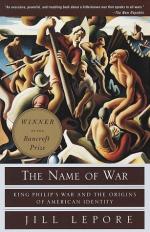
|
| Name: _________________________ | Period: ___________________ |
This test consists of 5 multiple choice questions, 5 short answer questions, and 10 short essay questions.
Multiple Choice Questions
1. When the Puritans came to America, the Algonquians were thought to be what?
(a) Literate.
(b) Angels.
(c) Civilized.
(d) Nomads.
2. According to the author, accounts of King Philip's War that were apocalyptic, with some being sermons, were mostly printed where?
(a) London and New York.
(b) New York.
(c) London and Paris.
(d) Boston and Cambridge.
3. What name refers to the mostly Puritan and Pilgrim immigrants from Great Britain who settled New England starting around 1630?
(a) The Spanish Colonists.
(b) The British Brigade.
(c) The English Arrivals.
(d) The English Colonists.
4. The colonists lost about how many men in the Great Swamp Fight?
(a) 59.
(b) 67.
(c) 70.
(d) 25.
5. When was the book A Relation of the Troubles which Have Hapned in New-England by Reason of the Indians There from the Year 1614 to the Year 1675 published?
(a) 1676.
(b) 1642.
(c) 1612.
(d) 1677.
Short Answer Questions
1. Sassamon was a Christian minister in what Indian praying town?
2. King Philip's War began in June of what year?
3. Who was fiercely competitive with William Hubbard and even campaigned to discredit Hubbard's account of the war?
4. The witnesses who testified against Sassamon's accused killers were Patuckson and who?
5. When did Nathaniel Saltonstall die?
Short Essay Questions
1. What reasons did the Narragansetts give for their attack on Providence, as described in Chapter 4, Where is Your O God?
2. How did the actions of the English impact the Native American people, according to the author in the Prologue?
3. When did King Philip's War begin, according to the author in the Prologue? What tribes were involved?
4. In what regard is John Pynchon discussed in Part One, Language, Chapter 2, The Story of It Printed?
5. Who was accused of the murder of John Sassamon? How does the author describe Metacom's reaction in Part One, Language, Chapter 1, Beware of Any Linguist?
6. How were homes used as a metaphor by Nathaniel Saltonstall, as described in Part Two, War, Chapter 3, Habitations of Cruelty?
7. What publication did Nathaniel Saltonstall write of the war? How is it described in Part Two, War, Chapter 3, Habitations of Cruelty?
8. What was problematic for the Puritans in their plight to maintain a civil identity, as discussed in the Prologue?
9. How does the author describe the spiritual views of the Native Americans regarding the war in Chapter 4, Where is Your O God?
10. How did the loss of property impact the Puritans, as discussed in Part Two, War, Chapter 3, Habitations of Cruelty?
|
This section contains 884 words (approx. 3 pages at 300 words per page) |

|




